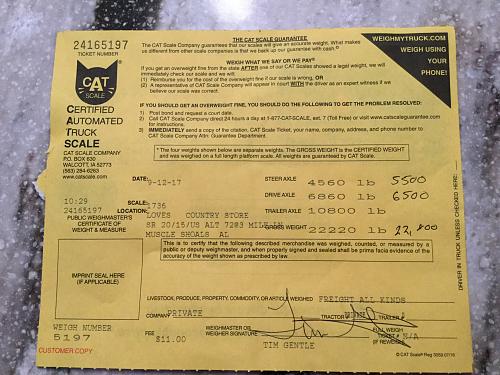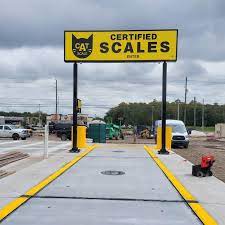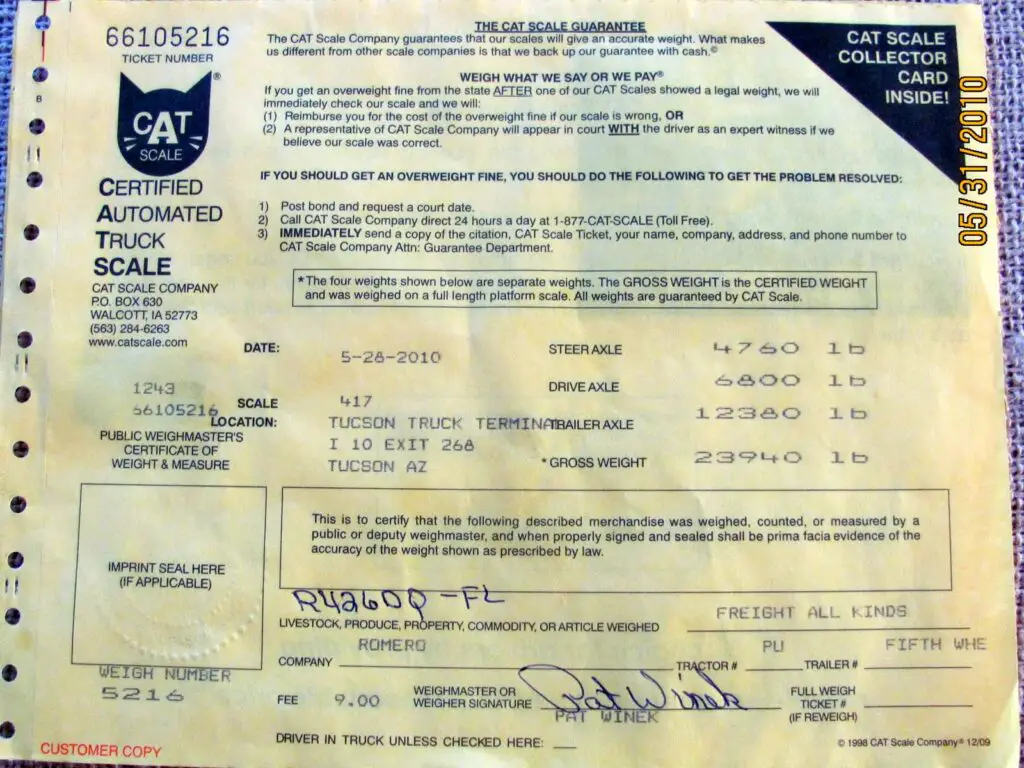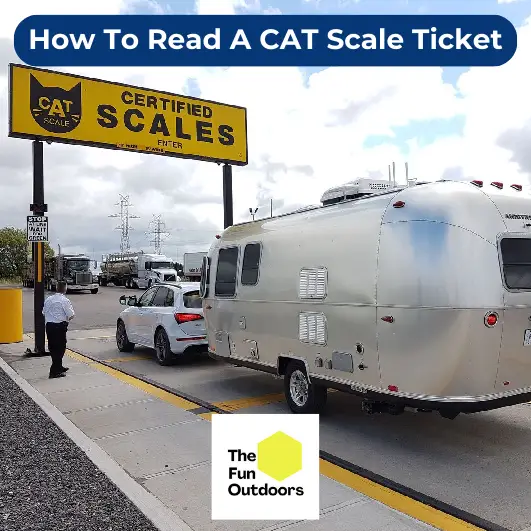If you’re a commercial driver, you know how important it is to properly weigh your vehicle. That’s where CAT scales come in. CAT scales are widely used by truckers, RVers, and other drivers to ensure they’re within legal weight limits and avoid overweight fines. When you weigh your vehicle at a CAT scale, you’ll receive a CAT scale ticket that provides important information about your weight distribution. Reading a CAT scale ticket can be confusing if you’re not familiar with the terminology and layout.
In this article, we’ll explain how to read a CAT scale ticket and provide tips on weighing your vehicle. We’ll break down the different sections of the ticket, including axle weights, gross weight, and net weight. We’ll also discuss legal weight limits and compliance, dealing with overweight fines, and the reweighing and verification process.
By the end of this guide, you’ll have a better understanding of how to read a CAT scale ticket and why it’s important to weigh your vehicle properly.
Quick Facts
- Understanding how to read a CAT scale ticket is crucial for commercial drivers to ensure compliance with legal weight limits and avoid overweight fines.
- CAT scale tickets provide important information about weight distribution, including axle weights, gross weight, and net weight.
- In addition to reading your CAT scale ticket, it’s important to understand legal weight limits, comply with regulations, and properly reweigh your vehicle if necessary.
Understanding the Cat Scale Ticket

When you weigh your truck or RV on a CAT scale, you will receive a CAT scale ticket. Understanding the information on the ticket is crucial to ensure that your vehicle is within the legal weight limits and to avoid any safety issues.
Let’s break down the different sections of the CAT scale ticket so you can understand what each part means:
Scale Ticket Basics
The CAT scale ticket is a legal document that provides essential information about your vehicle’s weight. The ticket consists of three sections: Scale Information, Weigh Information, and Product Information.
The Scale Information section provides details about the scale, such as the scale number, location, and operator.
The Weigh Information section shows the weight of the vehicle, including the Gross Vehicle Weight (GVW), steer axle weight, drive axle weight, and trailer axle weight.
The Product Information section displays the type of product weighed, such as a truck or RV.
Date and Time on Ticket
The date and time on the CAT scale ticket are essential to ensure that you have the most current weight information for your vehicle.
The date and time are usually located at the top of the ticket and are displayed in a 24-hour format.
It is important to ensure that the date and time on the ticket match the time you weighed your vehicle.
Truck Information on Ticket
The Truck Information section of the CAT scale ticket provides details about your vehicle, such as the make and model, license plate number, and registered weight.
The registered weight is the maximum weight allowed for your vehicle, including the weight of the vehicle, passengers, cargo, and any accessories. If the weight of your vehicle exceeds the registered weight, you may be subject to fines or other penalties.
Breaking Down Axle Weights

When reading a CAT scale ticket, it’s important to understand the information provided about the weight of your vehicle’s axles.
This information can help you ensure that your vehicle is within legal weight limits and properly balanced for safe driving.
Steer Axle Weight
The steer axle is the front axle of your vehicle, and its weight is listed on the CAT scale ticket under the “Steer Axle Weight” section. This weight is important because it affects your vehicle’s steering and handling.
If the steer axle weight is too high, your vehicle may be difficult to steer and control.
Drive Axle Weight
The drive axle is the axle that powers your vehicle’s wheels, and its weight is listed on the CAT scale ticket under the “Drive Axle Weight” section. This weight is important because it affects your vehicle’s acceleration and braking.
If the drive axle weight is too high, your vehicle may have difficulty accelerating and stopping.
Trailer Axle Weight
The trailer axle weight is the weight of the axles on your vehicle’s trailer, and it is listed on the CAT scale ticket under the “Trailer Axle Weight” section. This weight is important because it affects the stability of your vehicle while towing.
If the trailer axle weight is too high, your vehicle may sway or become unstable while driving.
When reading the CAT scale ticket, it’s important to ensure that the weight of each axle is within legal limits. In addition, it’s important to ensure that the weight is properly distributed between the axles to ensure safe and stable driving.
Legal Weight Limits and Compliance

When it comes to hauling cargo, it’s essential to ensure that you comply with legal weight limits. Overloading your vehicle can result in fines, and in some cases, you could be denied access to certain roads or bridges.
In this section, we’ll cover the basics of legal weight limits and compliance.
Understanding GVWR
GVWR stands for Gross Vehicle Weight Rating. It’s the maximum weight that a vehicle can safely carry, including its own weight and the weight of its cargo and passengers.
The GVWR is determined by the vehicle manufacturer and is listed on the vehicle’s compliance plate.
Exceeding the GVWR can result in damage to the vehicle’s suspension, brakes, and other components, as well as making it more difficult to control the vehicle.
Legal Limits for Axles
In addition to the GVWR, there are legal limits for the weight carried by each axle of the vehicle. These limits vary depending on the number of axles and the distance between them.
Exceeding the legal limit for any axle can result in fines, damage to the vehicle, and potential safety issues.
It’s important to distribute the weight of your cargo evenly across the axles to ensure that you comply with legal weight limits.
Uneven weight distribution can affect the vehicle’s handling and stability, making it more difficult to control.
Compliance with Legal Weight Limits
To comply with legal weight limits, it’s essential to weigh your vehicle and its cargo on a certified scale. The Cat Scale is a popular choice for truck drivers and RVers, as it provides accurate weight measurements and is widely available across the United States.
When you weigh your vehicle on a Cat Scale, you’ll receive a ticket that shows the weight of each axle group, as well as the gross weight of the vehicle.
It’s important to ensure that the weight of each axle group does not exceed the legal limit for that group, and that the gross weight of the vehicle does not exceed the GVWR.
By complying with legal weight limits, you can avoid fines, damage to your vehicle, and potential safety issues. Always ensure that your cargo is distributed evenly across the axles, and weigh your vehicle regularly to ensure compliance with legal weight limits.
Dealing with Overweight Fines
If you receive an overweight citation after weighing legal on a CAT Scale, you are protected by their exclusive Guarantee. CAT Scale offers an unconditional guarantee that states, “If you get an overweight fine from the state after our scale showed you are legal, we will immediately check our scale. If our scale is wrong, we will reimburse you for the fine.”
Avoiding Overweight Fines
To avoid overweight fines, it is important to weigh your vehicle and load on a CAT Scale before hitting the road. Make sure to check the weight limits for your vehicle and load and ensure that you are not exceeding them.
If you are unsure about the weight of your vehicle or load, it is always better to be safe than sorry and weigh it on a CAT Scale.
Reimbursement for Fines
If you do receive an overweight fine after weighing legal on a CAT Scale, it is important to contact CAT Scale immediately.
They will check their scale to ensure that it is accurate and if it is found to be wrong, they will reimburse you for the fine. Keep in mind that CAT Scale only reimburses fines that are a result of their scale being inaccurate. If you are found to be overweight on another scale, CAT Scale cannot reimburse you for any fines.
Reweighing and Verification Process
How to Reweigh
If you need to reweigh your vehicle, CAT Scale offers a reweighing service for a fee of $4.00. To reweigh, you must present your full-priced ticket and have it recorded on the reweigh ticket.
The reweigh must be done at the same scale as the full-priced ticket and within 24 hours of the original weigh-in.
To begin the reweigh process, follow these steps:
- Pull onto the scale and park your vehicle.
- Go to the scale office and request a reweigh.
- Present your full-priced ticket and have it recorded on the reweigh ticket.
- Return to your vehicle and wait for the scale attendant to signal you to proceed.
- Drive onto the scale and wait for the weigh-in to complete.
Verification of Weight
After you have weighed your vehicle, it is important to verify that the weight is accurate. Verification can be done by weighing your vehicle again or by having a witness present during the weigh-in.
If you suspect that the weight on your CAT Scale ticket is incorrect, you may request a verification of weight. This can be done by following these steps:
- Request a verification of weight from the scale attendant.
- Drive off the scale and park your vehicle.
- Wait for the verification weigh-in to complete.
- Compare the weight on the verification ticket to the weight on your original ticket.
- If the weights are different, speak with the scale attendant to resolve the issue.
It is important to note that CAT Scale does not reimburse for any weight discrepancies that occur after you have left the scale. Therefore, it is important to verify your weight before leaving the scale.
Cat Scale in Different Locations
If you’re a commercial driver, you may need to weigh your vehicle at a Cat Scale. Cat Scales are located across the United States and Canada, making it easy for drivers to find a location near them.
Here’s what you need to know about Cat Scales in different locations.
Cat Scale in the United States
Cat Scales are widely available in the United States. You can find them at truck stops, rest areas, and other locations along major highways. Some of the major chains that offer Cat Scales include Pilot Flying J, Love’s Travel Stops, and TA Petro.
When you arrive at a Cat Scale in the United States, you’ll need to follow the instructions on the scale. You’ll typically need to enter your truck’s information, such as the number of axles and the weight. Once you’ve entered this information, you can drive onto the scale and weigh your vehicle.
Cat Scales in the United States offer an unconditional guarantee. If you get an overweight fine from the state after the Cat Scale showed you were legal, the company will immediately check their scale. If their scale is wrong, they will reimburse you for the fine. If their scale is correct, a representative of the Cat Scale Company will appear in court with you as a witness.
Cat Scale in Canada
Cat Scales are also available in Canada, although they may be less common than in the United States. You can find Cat Scales at truck stops and other locations along major highways. Some of the major chains that offer Cat Scales in Canada include Husky and Petro-Canada.
When you arrive at a Cat Scale in Canada, you’ll need to follow the instructions on the scale. You’ll typically need to enter your truck’s information, such as the number of axles and the weight. Once you’ve entered this information, you can drive onto the scale and weigh your vehicle.
Cat Scales in Canada also offer an unconditional guarantee like in the US.
Other Stuff You Should Know
Here are some additional details that you might find helpful when reading your Cat Scale ticket.
Standard Trailer Specifications
If you are hauling a standard trailer, it is important to know the legal weight limits for your specific trailer type. In general, the maximum weight allowed for a standard trailer is 80,000 pounds.
There are some exceptions to this rule, such as when hauling an oversized load or using a specialized trailer. Always make sure that you are within the legal weight limits for your specific trailer type.
CDL Requirements
If you are driving a commercial vehicle, you may need to have a Commercial Driver’s License (CDL). The requirements for obtaining a CDL vary by state, but in general, you must be at least 18 years old to obtain a CDL for intrastate driving and 21 years old for interstate driving. You will also need to pass a written test and a driving test.

